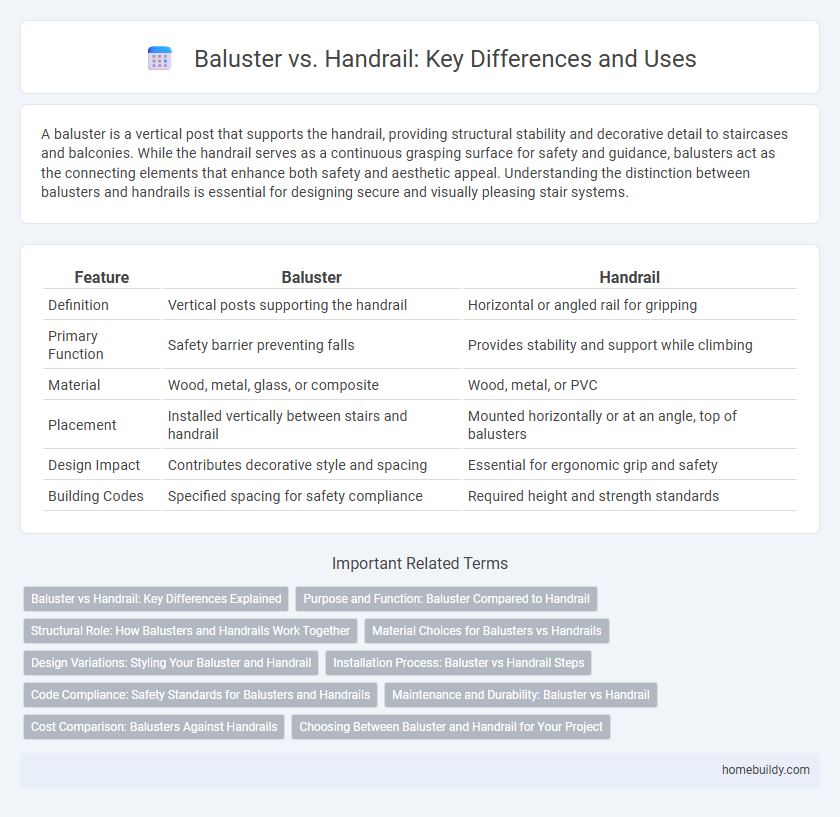A baluster is a vertical post that supports the handrail, providing structural stability and decorative detail to staircases and balconies. While the handrail serves as a continuous grasping surface for safety and guidance, balusters act as the connecting elements that enhance both safety and aesthetic appeal. Understanding the distinction between balusters and handrails is essential for designing secure and visually pleasing stair systems.
Table of Comparison
| Feature | Baluster | Handrail |
|---|---|---|
| Definition | Vertical posts supporting the handrail | Horizontal or angled rail for gripping |
| Primary Function | Safety barrier preventing falls | Provides stability and support while climbing |
| Material | Wood, metal, glass, or composite | Wood, metal, or PVC |
| Placement | Installed vertically between stairs and handrail | Mounted horizontally or at an angle, top of balusters |
| Design Impact | Contributes decorative style and spacing | Essential for ergonomic grip and safety |
| Building Codes | Specified spacing for safety compliance | Required height and strength standards |
Baluster vs Handrail: Key Differences Explained
Balusters are vertical posts that provide support and safety by filling the space between the handrail and the staircase or balcony, while handrails are horizontal or angled rails designed for gripping and guiding users. The key difference lies in their function: balusters primarily offer structural stability and prevent falls, whereas handrails serve as a grip for balance and support. Understanding this distinction is crucial for effective staircase design, ensuring both safety and aesthetic appeal.
Purpose and Function: Baluster Compared to Handrail
Balusters provide vertical support and safety by preventing falls while adding architectural detail, whereas handrails offer a continuous grip for balance and guidance along stairs or ramps. The primary function of balusters is to maintain the structural integrity of the railing system and enhance aesthetic appeal. Handrails focus on user safety and accessibility by delivering a steady handhold during movement.
Structural Role: How Balusters and Handrails Work Together
Balusters provide vertical support and stability to the handrail, distributing weight and preventing lateral movement. Handrails serve as the primary gripping surface, offering guidance and safety while ascending or descending stairs. Together, balusters and handrails form an integrated structural system that enhances both strength and user security in stair design.
Material Choices for Balusters vs Handrails
Balusters commonly feature materials such as wood, wrought iron, and glass, selected for both structural support and decorative appeal, while handrails prioritize materials like hardwood, metal, and composite for durability and grip comfort. Wood balusters offer intricate designs and warmth, contrasting with metal handrails that provide sleek, modern aesthetics and enhanced sturdiness. Glass balusters create a transparent barrier enhancing visibility, whereas handrails emphasize ergonomics and strength to ensure safety during use.
Design Variations: Styling Your Baluster and Handrail
Balusters offer diverse design variations ranging from classic turned wood to modern metal and glass styles, allowing customization that complements both traditional and contemporary handrails. Handrails serve as the primary grip surface and are available in various shapes and materials, such as sleek stainless steel or ornate carved wood, to enhance the overall aesthetic while ensuring safety. Styling your baluster and handrail together creates a cohesive look, with unique patterns and finishes that define the staircase's character and architectural appeal.
Installation Process: Baluster vs Handrail Steps
Baluster installation involves securing each vertical post to the stair tread or floor and aligning them precisely to ensure stability and safety, often requiring precise measurements and drilling for anchor points. Handrail installation includes mounting brackets to the wall or balusters, then attaching the rail so it is level and securely fastened, prioritizing grip comfort and continuous support. Both processes demand careful planning, but balusters focus on structural support, while handrails emphasize ergonomic placement and seamless connection.
Code Compliance: Safety Standards for Balusters and Handrails
Balusters and handrails must meet specific code compliance and safety standards to ensure structural integrity and fall prevention in staircases and balconies. Building codes such as the International Residential Code (IRC) mandate that balusters be spaced no more than 4 inches apart to prevent small children from slipping through, while handrails require a graspable diameter between 1.25 to 2 inches for secure handholds. Both components play distinct roles in safety: balusters act as vertical guards to block falls, whereas handrails provide continuous support for users, making adherence to these standards critical for overall building safety.
Maintenance and Durability: Baluster vs Handrail
Balusters typically require less frequent maintenance than handrails due to their smaller surface area and limited contact points, reducing wear and tear. Handrails, being regularly touched and leaned on, demand more durable materials and periodic upkeep such as sanding or refinishing to prevent splintering and maintain safety. Choosing materials like metal or treated wood for both balusters and handrails enhances their durability, minimizing long-term maintenance efforts.
Cost Comparison: Balusters Against Handrails
Balusters generally have a lower upfront cost compared to handrails due to their simpler design and smaller size, but the total expense can increase with the number required for a staircase. Handrails often involve higher material and installation costs because of their length, shape, and the need for durable materials like hardwood or metal. When budgeting, factoring in the complexity of installation and maintenance costs for each component provides a more accurate cost comparison between balusters and handrails.
Choosing Between Baluster and Handrail for Your Project
Balusters provide vertical support and aesthetic detail in staircases, while handrails offer a continuous grip for safety and stability. When choosing between balusters and handrails for your project, consider the balance between structural functionality and design preferences. Prioritize handrails for safety compliance and balusters for decorative impact in stairway construction.
Baluster vs Handrail Infographic

 homebuildy.com
homebuildy.com